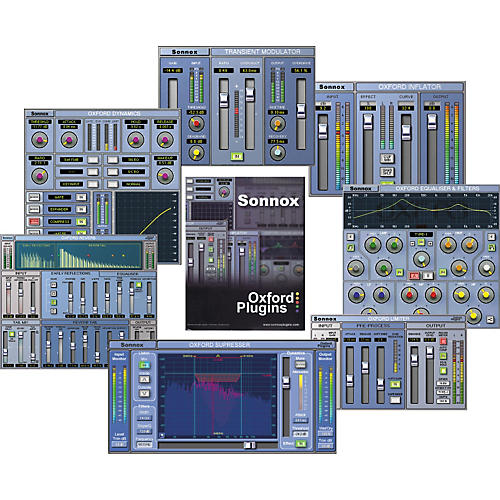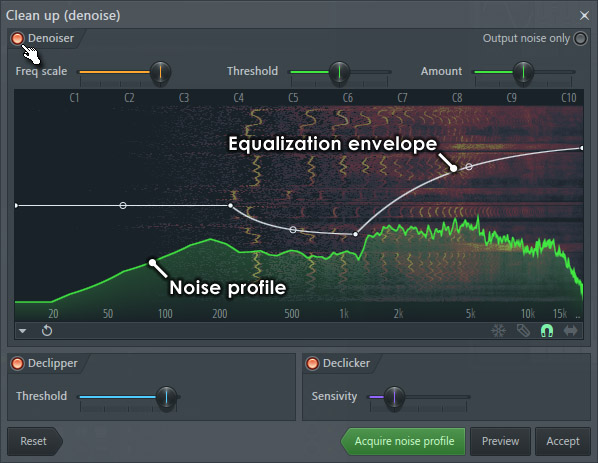
Operation is made easier by the ability to bypass each section and to audition the noise being removed: if you drop the threshold too far, you start to recognise wanted transients and other elements from the wanted sound being treated. There's also a side‑chain filter that allows you to tailor the signal used to key the dialogue/silence gate. This is exactly what Sonnox have done, allowing you to drag a threshold line in a dynamic display of the input signal. The obvious solution is to have two alternate parameter sets, one of which is active below a level threshold and the other above it.

It is also possible to automate the limits of the Exclude box for different sections of an audio file, and the Exclude box can be used to prevent the unnecessary correction of small noises that are normally masked by the wanted signal.ĭialogue Mode addresses specific problems associated with removing clicks from spoken‑word material, where the process needs to be different during the speech than for the spaces between words and phrases. Only one Exclude box can be active, though you could process the same material twice with different settings if you need to. There are certain types of instrument that can produce 'false positives', such as raspy brass, so the interface includes the useful option to draw in an Exclude box to define a frequency area and level threshold window within which detected clicks should not be repaired. If a section is disabled, its bubbles turn red, showing that they are not being corrected. The display shows detected noises as 'bubbles', colour‑coded green for pops, blue for clicks and white for crackles their size and height above the axis relates to how loud they are.

Small residual clicks can be dealt with using the de‑crackle part of the process.
#Free declicker vst full#
A practical strategy for dealing with clicks is to first set the Threshold just above the noise floor so that the full width of each click is detected, then adjust the Sensitivity slider so that only clicks above a desired level are dealt with. The Threshold control makes the detection of excitation peaks more or less sensitive, while a separate Sensitivity control sets which of them are repaired and which are ignored. A click thus shows up in the excitation profile display as a triangular‑shaped peak. The idea is that a high excitation value will be detected when a large, harmonically rich event, such as a click, occurs. Each of the three sections calculates what Sonnox call an Excitation Profile: this is displayed in its own window, and is basically a measure of how far the harmonic make‑up of the sound differs from its predicted harmonic content. Sonnox define a pop as a noise lasting between three and 10 milliseconds and a click as anything from 0.4 to three milliseconds, while noises shorter than 0.4ms are treated by the crackle section. The DeClicker plug‑in actually comprises three different processing sections, each with its own processing threshold control, and each designed to target noises of different durations, designated as pops, clicks and crackles. As these plug‑ins are likely to be used only when recording is complete, the resulting latency times will not be an issue.
#Free declicker vst driver#
RTAS, Audio Units and VST platforms are supported on both Mac and Windows PC at sample rates up to 96kHz, with protection via iLok.Īll three plug‑ins use internal buffer sizes of 1024 samples for 44.1kHz and 48kHz operation and 2048 samples for 88.2kHz and 96kHz operation Sonnox advise that driver buffer sizes be set to the same value, to optimise the efficiency of audio data transfer. Typical applications include the removal of pops, clicks, crackles, scratches, hum, buzzes, hiss and other types of unwanted background noise.
#Free declicker vst software#
The software is based on a new algorithmic approach to noise removal, with a focus on minimising processing artifacts combined with an innovative graphical user interface design. The suite comprises Oxford DeClicker, Oxford DeBuzzer and Oxford DeNoiser, all of which must be purchased as a bundle. Sonnox Restore is a suite of three problem‑solving plug‑ins designed to reduce specific types of noise artifacts in recorded material. Signal below the user‑defined threshold is shown in red, and treated differently from signal above the threshold.

Sonnox Oxford DeClicker in Dialogue mode.

Sonnox's trio of plug‑ins offers some new and unusual features and a friendly interface. If you're in the market for a high‑quality restoration package, there is no shortage of contenders.


 0 kommentar(er)
0 kommentar(er)
